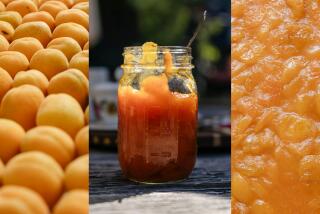Gifts of Taste : The Littlest Oranges
- Share via
A 16th-Century Chinese herbal tells of the custom of presenting visitors with the gift of a small tree shimmering with edible jewels. Its name was “give-guest orange”--the kumquat. Introduced to Europe in the 19th Century, the trees were set as ornaments on fashionable tables, and give-guest oranges were plucked from the centerpiece for nibbling. This lovely notion drifted back to the Orient, with the refinement that centerpieces of bonsai kumquat trees invite the diners’ pleasure.
Probably native to eastern Asia and the Malay Peninsula, kumquat fruits are a yin-yang mix of honeyed skin and tangy flesh (botanically, they’re a berry). There’s a trick to coaxing the most sweetness from a kumquat when eating it fresh: Gently roll it back and forth in the palms of your hands until it’s softened--this releases sugars from the peel and blends them into the tangy pulp. (Try it, then eat an unrolled kumquat of the same batch. Amazing.) You can also cheat, nipping off an end, squeezing out some juice, thus making the flavor sweeter. As for seeds, there aren’t many, and they’re small and sweet enough not to notice.
Some cultivars of kumquats are sweeter than others. Of standard fruit, oval to round Meiwa is considered the best for eating fresh. Oval Nagami is considered best for preserving. Changshou fruits are tear-shaped and--surprise--the size of small plums. Developed in China, they’re a cross between a kumquat and mandarin orange, although the flavor is sweetest kumquat. Changshou is the favorite of kumquat fanciers these days, and even the tree is considered superior.
*
Reading about kumquats, I learned the Chinese have been preserving the fruits in honey for centuries. According to George York, food preservation specialist at U.C. Davis, to preserve kumquats in honey, cut in half, turn into a clean jar and cover with honey. Heat on the defrost level in the microwave for three to four minutes (depending on the size of the kumquats). This softens the honey so the kumquats can be thoroughly covered. Covered and kept in a cool place, the kumquats should last six months.
Use the preserve as the basis for fruit cups as other fruits come in season. Even better, enjoy them as what the Greeks call a spoon sweet--serve in a tiny saucer and coax the kumquats and honey from a spoon, accompanied with a cup of flowery tea.
York mentioned that the Chinese and Japanese also preserve kumquats in sugar. Simply pack halves of kumquats in a clean jar layered with sugar. If you want to drop in a teaspoon of brandy or rum to each pint, the alcohol will act as a starter, and in time you’ll have brandied kumquats. (This reminded me of the way our great-grandmothers packed peaches with sugar in August, buried the jars deep in cool earth, then pulled up brandied peaches in December. I’ve done it. It works.) Ladle hot as a sauce over vanilla ice cream.
*
You can drop the fruit whole into the honey or sugar, but halving fruits makes the interior immediately accessible to the preserving compound. There’s no chance of botulism with either method, by the way. Because of the pronounced acidity of the fruit (increased by the acidity of honey), the worst that can happen is that the stuff ferments. Kept in a cozy cupboard, this once happened to my kumquat honey--it tasted powerfully winey. York assured me the result of alcoholic fermentation is safe to eat--in fact, he sounded downright cheerful at the prospect.
Remember that honey has its own assertive flavor, so the milder the honey, the better balance between honey and kumquats. Unfiltered honey from orange blossoms is ideal.
Kumquats brighten a season when there’s little interesting fruit. Around Southern California, one cultivar or another is ripe from mid-November through mid-March.
Small shapes of luminous color, kumquats are as esthetic as they are delicious. I must tell you what I’ve recently discovered that makes beautiful use of them: Crystallize kumquats with bunches of red grapes, lady apples and Seckel pears. Together, their diminutive size, warm colors and sensuous curves make an exquisite centerpiece or arrangement for a gift basket.
*
Beat an egg white just until loosened. With a small flat paint brush (cheap from the hardware store), paint every nook and cranny of a piece of fruit or bunch of grapes with egg white. Set the fruit in a bowl and douse with superfine sugar, turning the fruit until it’s completely covered. If there are bare patches, brush with egg white and sugar again.
As you finish each piece, set it on a cake rack to dry. Don’t hurry this part; give it a few hours at least. The fruit is ready to arrange when the sugar is snowy-opaque. If the air is dry and the fruit is kept in a cool place out of sunlight, the finish and fruit itself will last weeks. My arrangement is a month old, and only the grapes show signs of their sugar dissolving.
Either buy superfine sugar or whirl granulated sugar in the blender until superfine. For years I crystallized fruit with granulated sugar, but superfine makes fruit look as though it came straight from Jack Frost’s garden.
Past their physical charms, kumquats are a natural for turning into sunny marmalades, preserves and sweet pickles. And each Christmas we wait for a friend’s gift of kumquat chutney. The recipe is her secret, but I’ll bet you can substitute halves of kumquats for the coarsely chopped fruit in any orange or lemon chutney recipe.
*
The tangy sweetness of kumquats makes them also a natural for garnishing meats. The French are partial to kumquats roasted with duck. In the south of France, where oranges flavor braised beef, why not kumquats in the daube instead? In fact, any recipe using orange flesh and skin can be adapted to whole kumquats. And an English writer suggests using kumquats in recipes in place of preserved ginger.
The tree? Enormously ornamental. The small orange or orange-gold fruits are thick amid glossy dark-green leaves and the shape is naturally symmetrical. Standard kumquat trees flower and set fruit in summer--the white blossoms are richly fragrant; Changshou flowers in early spring and ripens from August on. Although pollinated by wind and insects, kumquat blossoms don’t need the blossoms from another tree to set fruit. To fulfill its potential, the plant needs a long hot summer and humidity. Heat makes the fruit large, humidity makes it juicy. Thus fruit grown along a warm coast is small and juicy, and fruit grown in the hot desert is comparatively larger and drier.
In the ground or in a container, give a kumquat full sun. Naturally small, the tree can be kept at six to eight feet--a half-barrel is its ultimate tub size. If you bring home a tree now, wait until the earth is warm to put it in the ground. Three to four feet of well-drained soil is all that’s needed, but it is necessary. Clay soil stresses citrus. If yours is adobe, amend it with compost (from your compost pile or from bags at the nursery).
In winter when it’s semi-dormant, water the way you do other shrubs. In other seasons, keep the soil on the moist side--less water more frequently is the rule.
*
To fertilize organically, each spring, mulch with well-aged compost or manure. Mulch to the drip line, leaving a two-foot clearance around the trunk. However, citrus needs micronutrients, so even this passionate organic gardener applies a commercial fertilizer. I follow directions in “Citrus” by Richard Ray and Lance Walheim (HP Books).
Added to its other virtues, kumquats are the hardiest of citrus. The tree can survive cold at least as low as 20 degrees. Where it gets colder in winter, bring the tree indoors for the season. Set the tub somewhere sunny or brightly lit and above 45 degrees. Mist the air often but be sparing with water, then don’t return the tree to the outdoors until the air is warm during the day and night.
Pick kumquats when a test fruit is sweet--they don’t have to lose all tinge of green to be ripe. You can let standard kumquats hang on the tree for months without loss of quality (although too long, and you’ll interrupt the cycle and next year may see less fruit). Changshou kumquats will hold three to four weeks after ripening.
Give-guest oranges? By all means.
Sources
Fresh: Fruit is usually at the market from December through some part of spring.
Plants: Kumquat trees for sale in Los Angeles County must be stripped of ripe fruit--the Medfly quarantine. Meiwa is available at Papaya Tree Nursery in Granada Hills, (818) 363-3680.
All cultivars mentioned are available from Pacific Tree Farm in San Diego County. They will deliver for a fee. (619) 422-2400. Both have bearing-age trees in 5- and 15-gallon pots.
*
Here’s another way with kumquats and honey, a honeyed marmalade. Whether you slice the fruits into translucent rounds or chop them into crunchy bits, the flavor and color are sublime. An unusual and easily made gift.
KUMQUAT HONEY
1 1/2 cups thinly sliced or chopped ripe kumquats, packed, with most seeds removed, to equal 1/2 pound
1 cup unfiltered orange blossom honey
Combine kumquats and honey in 1-quart microwave-safe bowl. Cover with plastic wrap. Cook on DEFROST level in microwave oven 3 minutes. Or place over, but not touching, barely simmering water 5 minutes.
Turn into clean 1-pint jar. Cover with lid. Store in refrigerator or cool place. Stir to blend before serving. Makes 1 pint.
Each 1-tablespoon serving contains about:
37 calories; 1 mg sodium; 0 cholesterol; 0 fat; 10 grams carbohydrates; 0 protein; 0.26 gram fiber.
(BEGIN TEXT OF INFOBOX / INFOGRAPHIC)
The Blooming End
You can tell the blossom end of a kumquat by first looking for the stem end--that’s the end with a pale spot. The blossom end is opposite.
* PRESERVE THE KUMQUAT: Culinary SOS, this page
More to Read
Eat your way across L.A.
Get our weekly Tasting Notes newsletter for reviews, news and more.
You may occasionally receive promotional content from the Los Angeles Times.










